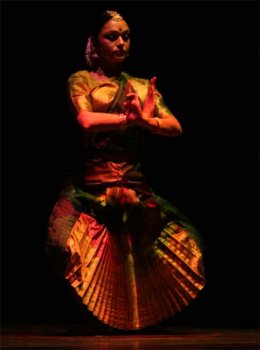
|  |

|  |
 Knee - Better be careful - Rama Vaidyanathan, New Delhi e-mail: vaidyanathan.rama@gmail.com August 8, 2009  The great araimandi - we spend a quarter of our lives trying to perfect it, the next quarter desperately trying to sustain it, and the remaining part of our lives moaning the loss of it. What to do! It’s the most beautiful and visually aesthetic principle of Bharatanatyam, and yet is supposed to be the most unnatural posture for the human body. Precisely why we dancers need to safeguard the two heroes who help us achieve that perfectly etched Ardha Mandala. Our knees - we never seem to realize how important they are till they give up… It was a cold winter morning in Delhi. I was rehearsing in my studio when I heard a “click” sound just as I was executing a surukkal adavu. I collapsed with excruciating pain, but somehow this pain paled before the terrible shock that awaited me. My orthopaedist told me that I had torn my meniscus (a cartilage between two bones) and had broken my Anterior Cruciate Ligament. I needed surgery and have to give up dancing for a year. The world ended for me and with tears I mustered courage to ask him the key question: “Will I be able to use my knees as well as before?” to which India’s top knee expert, Dr. Ashok Rajagopal’s simple one liner was, “Of course, in fact your injured knee will become stronger than the other one.” At that moment I did not believe him. But today in retrospect, my advice to dancers who are avoiding surgery and are trying to overcome their ligament and meniscus tears through rehabilitation is that, surgery is not the last option, it is the only option. There is just one simple argument that goes in its favour. As dancers we need more than 100% fit knees. Anything less will turn those heroes to villains! The surgery was an arthroscopy and I needed to be in the hospital just for a day. The last thing that Dr. Rajagopal told me in the operation theatre when I again expressed my concerns was, “Don’t worry, I did an ACL repair on the Badminton champion Pulella Gopichand, and he went on to win the UK open after his surgery.” I shut my eyes peacefully and lost myself to visions of me playing badminton on stage in a Bharatanatyam costume. Physiotherapy! It’s a necessary evil monster. It’s awfully painful and it requires every ounce of determination that one can gather to infuse movement into those stubborn knees. Doctors told me that the very purpose of the ACL repair and meniscus reconstruction would be useless if I did not follow the year long grueling physiotherapy regime. It starts with slow and simple movements, gradually moving on to vigorous exercises. After 3 months when I started dancing, beginning with the tatta adavu, I realized that simply by practicing my adavus, everything that the physio aimed for was happening. How beautifully our adavus have been crafted. Every single movement of every joint of the body is explored. I eventually drew up a routine which was a cocktail of physio exercises and Bharatanatyam movements. Hard work paid and within 6 months, I was back on stage. And yes, today my ACL repaired knee is much stronger than the other one. I learnt a lesson the hard way. This mishap could have been avoided if I had preceded my dancing sessions with warm up exercises. Did the devadasis ever warm up? I asked myself. Well, a traditional Bharatanatyam margam begins with a mallari and alarippu. These are by nature, numbers that warm up the dancer’s limbs. How many of us begin our practice sessions or performances with these numbers? Therefore it is absolutely imperative that we go through a warm up routine of about 30 minutes before we begin active dancing. Tying a 1 kg weight to the ankles helps strengthen the muscles around the knees. What about the floors of our dance spaces? It’s common knowledge that concrete floors do not absorb the shock of stamping feet, thereby increasing the chances of heel and knee injuries. Therefore investing in a wooden floor or any other floor meant for dance makes a lot of sense. Safeguarding our knees and timely repair to injuries will help in increasing our active dancing years. We need to keep those heroes in good humor. So Knee - better be careful! Responses Rama Vaidyanathan is one of India's leading Bharatanatyam dancers. She has been fortunate to have trained intensively under the legendry dancer Yamini Krishnamurty and Guru Saroja Vaidyanathan. Everyone who has seen Rama perform has been moved by her unique thought process and fresh approach to dance. While deeply routed in tradition she has evolved her own individual style without forsaking the core principles of Bharatanatyam. She belongs to the outstanding category of artistes at the ICCR, is a top graded dancer with the Doordarshan and has received the coveted Sanskriti Award instituted by the Sanskriti Pratishthan in Delhi. Rama has been performing for more than thirty years and is one of the most sought after dancers of her generation. ramavaidyanathan.com |